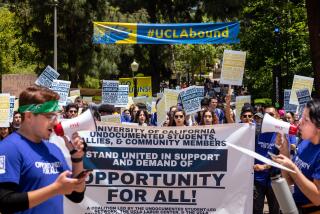Solving Californiaâs jobs crisis
As we enter the new year with a new governor, new Legislature and renewed commitment to restoring Californiaâs luster, our singular focus as a state must be on job creation in the short term and job competitiveness in the long term. A meeting held in Monterey in November might hold the key that unlocks the door to Californiaâs economic future.
In a small conference facility and with little fanfare, the University of California Curriculum Integration Institute brought together a group of teachers, researchers and administrators from across the state and country to develop new ways to teach our children. Their goal: Create high school courses that hold kidsâ interest and better prepare them for college and/or careers.
The UCâs role in a fundamental redesign of the educational experience is critical, because itâs the UC that defines rigor in California high schools through its role as arbiter of which courses qualify as college prerequisites. The California State University system has linked itself to these eligibility requirements as well, thus extending the UCâs influence over what and how many of our high school students are taught, whether they are college-bound or not.
There is no question the challenge of our time is jobs. The unemployment rate in California stands at 12.4%. But the more important numbers are these: Unemployment for Californians without a high school diploma is 19.2%; for those with a high school degree, 15.6%; for those with an associateâs (2-year college) degree, 9.1%; for those with a bachelorâs degree, 6.4%.
And 1 of every 5 high school students will drop out before receiving a diploma. For African American and Latino students, the numbers are more stark, with 2 out of every 5 dropping out.
These numbers lay bare the reality that if we are going to get serious about jobs in this state, we must get serious about the direct relationship between jobs and education. We need to align public education with the jobs that will exist in a knowledge-intensive, innovation economy.
In the 20th century, the stateâs public education system played a critical role in the creation of the jobs that made California one of the worldâs largest economies. Today, we need to align our schools with the labor market of the 21st century so that California can lead the world in fields such as clean energy and biotechnology, which will generate high-quality jobs. Look no further than what has happened in Silicon Valley to see the direct connection between what is being taught today and the jobs and industry of tomorrow.
Our kids must not only have access to college; they must be prepared to graduate from college. In this economy â and the economy of the future â the difference between having a job and not having a job will increasingly depend on whether you have some kind of education or training beyond high school.
This year the College Board announced that the United States had fallen from first to 12th in the share of adults ages 25 to 34 with postsecondary degrees. Other countries are improving rapidly and are graduating more students, while the U.S. numbers have been generally static. Global demand for college graduates means we will no longer be able to import our way out of this shortage â and why should we, when the solution should be homegrown? If post-high school education is the passport to a job, California must graduate students at a rate higher than the current 36% in order to compete globally.
As a state, we must increase college and career readiness and degree completion by first setting a âman on the moonâ goal of increasing the number of young adults with a postsecondary credential to 55% in 10 years.
If we are serious about preparing our students to fill those high-quality jobs, public education must not be a Democratic issue or a Republican issue. It must be a California issue, with all parties â business and labor, politicians, educators â coming together to find areas of agreement to foster the education transformation we need to serve Californians and drive a strong and sustainable recovery.
Thatâs exactly what happened in that meeeting in Monterey. The people in that room put aside the traditional battle lines drawn by various education factions. Instead, the UC Institute created an environment in which people started asking, and answering, the right questions.
Questions such as: What is the best way to teach algebra and geometry to high schoolers who now find it boring and abstract, so that they understand its application in fields including engineering, energy efficiency and agriculture?
How can we better recruit, keep, develop and support teachers who engage our students in not just the âwhatâ of their subject matter, but also the âwhyâ that makes it relevant to their futures?
How can we build stronger bridges between our K-12 system, our institutions of higher education and the businesses that will lead us to recovery?
The challenge of our time is jobs. But the key to job creation, economic development and sustained economic growth in California is a high-quality, and more relevant, education for our children. Letâs get our priorities straight and bring our education system into the 21st century.
Darrell Steinberg (D- Sacramento) is the California Senate president pro tem.
More to Read
Sign up for Essential California
The most important California stories and recommendations in your inbox every morning.
You may occasionally receive promotional content from the Los Angeles Times.










